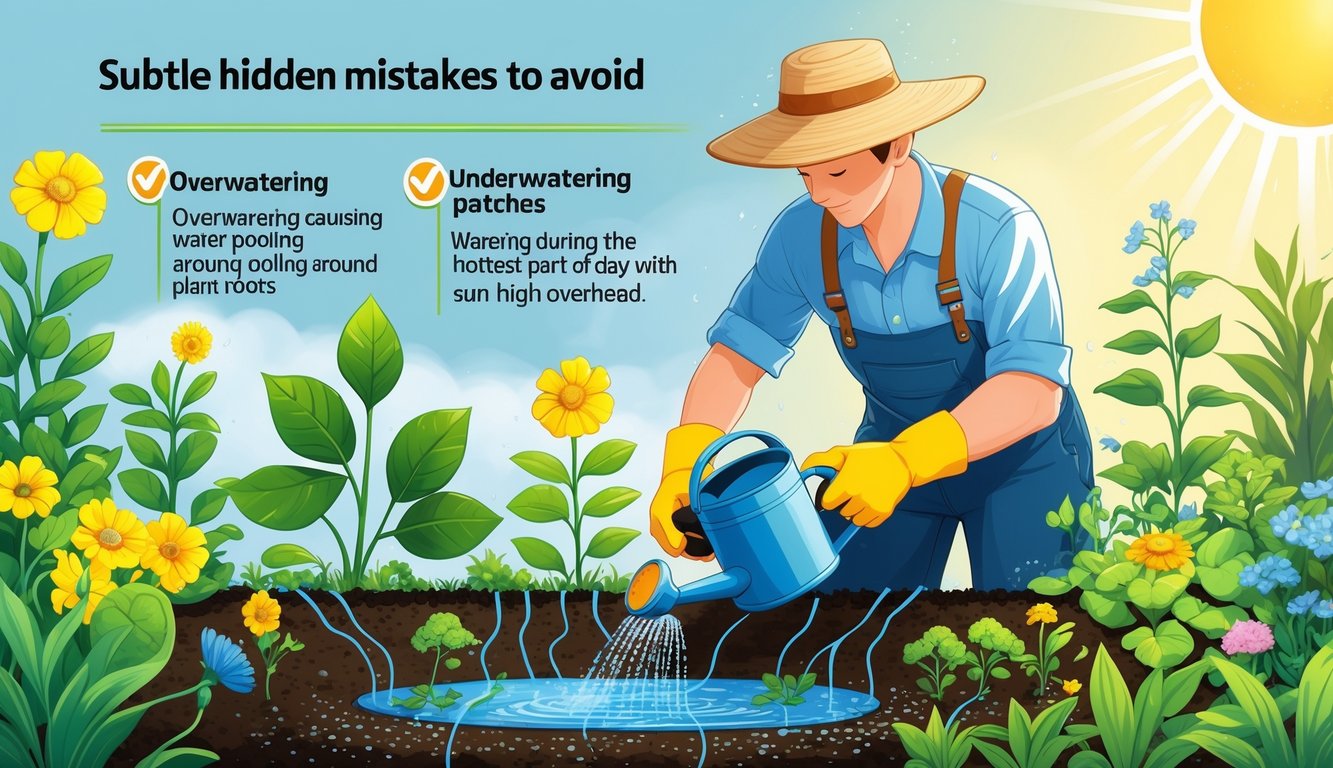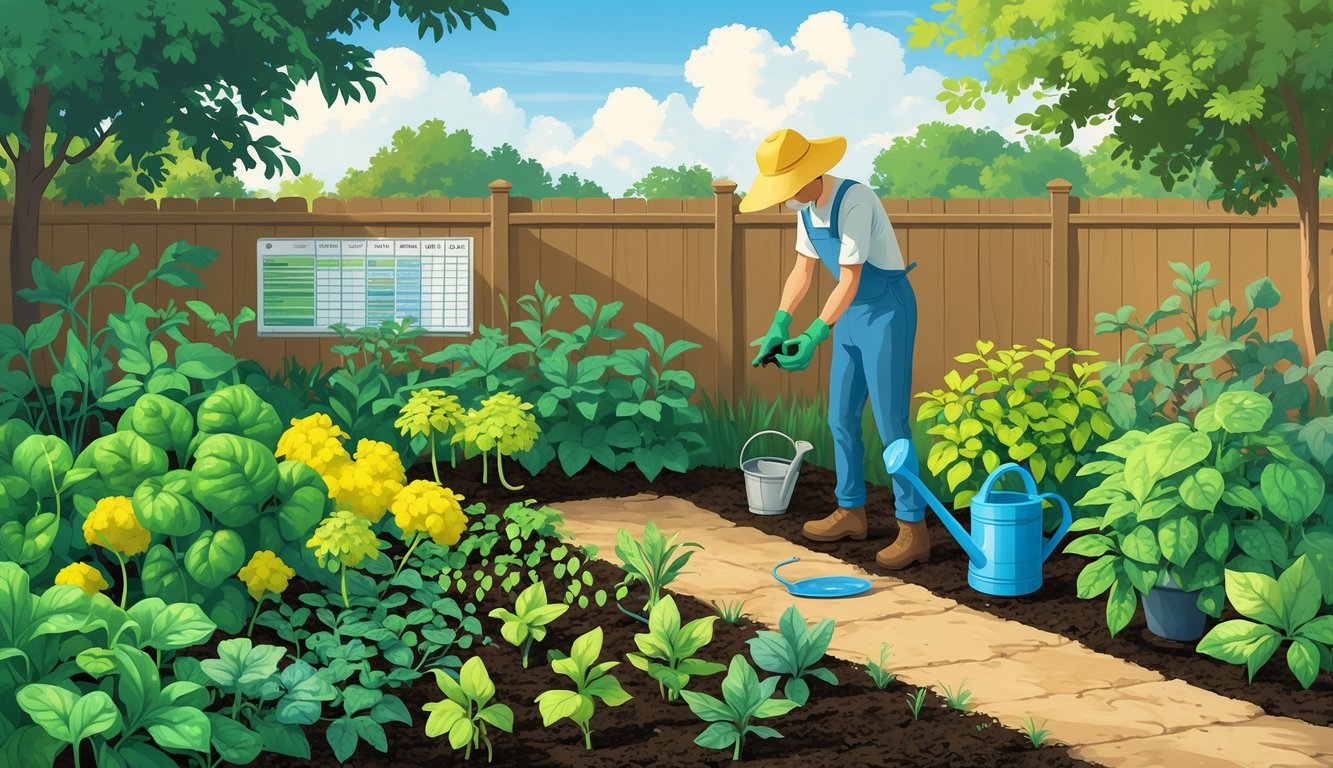
Recognizing Signs of Improper Watering

Plants don’t scream when they’re thirsty or drowning, but they definitely show you. One day everything’s fine, the next there’s limp leaves, droopy stems, and you’re panic-buying fertilizer or those weird water crystals.
Wilting and Other Early Warnings
Wilting drives me nuts. Noon rolls around, leaves are floppy, I panic and water, but by dusk they’re fine. Sometimes it’s just the heat, not thirst. I asked a horticulturist at the Missouri Botanical Garden; they said soil moisture is the only thing that matters. Jam your finger down there, or buy a cheap meter. Don’t trust the leaves alone.
I once drowned a patch of marigolds thinking I was helping. They turned yellow anyway. Roots hate sitting in soggy, airless mud. They can’t breathe, so the plant droops—not because it’s thirsty, but because it’s basically suffocating. Heat stress and drought stress look the same—curled leaves, faded color, crunchy edges—but if the soil below is damp, just give them shade and wait it out. Real drought stress? Brittle leaves and crispy tips.
Spotting the Signs of Overwatering and Underwatering
I see so many people dumping more water on limp plants—it’s almost always too much water, not too little. Overwatering suffocates roots, makes everything smell mushroomy, and pushes the plant to wilt because the roots are rotting. Root suffocation is explained here. Yellow leaves, leaf drop, mushy stems—none of that is “hungry,” it’s just drowning.
Underwatering is a different mess. Leaves get crispy, edges turn brown, everything shrinks. Sometimes you can save it if you catch it early. Don’t just look—pull back the mulch and actually feel the soil. Roots don’t lie, even if the leaves do.
Protecting Roots and Soil Health
Walking by my tomatoes, I realized roots can just suffocate and collapse if there’s too much water hanging around. Not because they’re “moody”—just because I turned my carefully prepped soil into a swamp. All the best watering hacks? They’re not about how often, but about not turning the garden into amateur hour.
How Root Rot Develops
Here’s the thing: I swear, root rot just sneaks up on you when you’re zoning out, watering like a robot. Suddenly, the soil’s this sad, swampy sponge, and you’re left wondering why your basil looks like it’s been through a monsoon. I mean, is it just me, or does everyone’s basil “melt” in July? Root rot isn’t some rare plant plague—more like a plant’s version of “help, I can’t breathe down here.”
Missouri Botanical Garden says (and they’re not wrong) that when there’s barely any oxygen left in the soil, roots basically give up and rot. Overwatering isn’t being nice—it’s suffocating them. That wilted, sad look? Not thirst. Just roots drowning in mud. I read somewhere that roots “hate sitting in a wet seat.” Sounds dumb, but it stuck.
Honestly, poking your finger in the dirt beats any fancy calendar watering schedule. Rain? Sometimes it just wets the top and leaves the rest soggy, like that gross rice at the bottom of the pot. Why is plant care always a guessing game?
Encouraging Strong Root Development
Let’s be real: shallow watering? Useless. Plants barely try. When you water deep, they dig in, chasing moisture, and they don’t freak out every time the sun gets aggressive. I keep seeing this 6–8 inches deep thing everywhere—grab a cheap soil probe if you don’t believe me. I did. Changed my whole approach.
Gardeners who’ve been at this forever swear by weekly deep soaks, not because it’s tradition, but because it actually works. Roots get tough, plants stop complaining, and you spend less time fussing. It’s weird, but skipping a watering now and then helped my potted stuff bounce back. Roots want air as much as water—why is this so hard to remember? Just don’t let them turn into crispy fries. I’m not a monster.
The Role of Mulching in Smart Watering
Everyone says they mulch, right? Then why do I keep seeing dried-out hydrangeas everywhere? Mulch isn’t just some pretty topping—it changes everything about how water sticks around. If you’re mulching at the wrong time or using the wrong stuff, you’re basically letting the sun steal half your effort.
Mulching for Moisture Retention
People overwater like it’s a competition, when mulch could do half that work. Organic mulch—bark, straw, compost—blocks sunlight and can slash evaporation by 70%. That’s not a typo. Just three inches, and suddenly the soil isn’t bone dry by noon.
But here’s the annoying part: people act like mulch is magic and forget to spread it right. I’ve dug up roots gasping for air under mulch mountains. Too much, and you’re suffocating them. There’s a sweet spot, but nobody agrees where it is. Mulch also blocks weeds, which is great, but nobody talks about how it turns into a slug hotel if you leave it messy. Why does no one warn you about that? “Use mulch,” they say, and then disappear.
Types of Organic Mulch for Summer Success
Bark, straw, leaves, compost—sure, they all hold water. But why does no one mention how bad some of them smell after it rains? Or how straw just vanishes with one gust of wind? I still use it for tomatoes, though—bark would smother the seedlings.
Honestly, compost mulch is underrated. It feeds the soil while holding water, but apparently, it’s only for established plants because it heats up and can fry baby seedlings (ask my peppers from last summer). Bark and wood chips? They last longer, so you’re not always topping them up. And “living mulches” like clover? Some people swear by them, but my neighbor’s dog just tears it up anyway. No real consensus—just chaos.
Here’s a table because nobody ever gave me a straight answer when I started out:
| Mulch Type | Moisture Hold | Breakdown Speed | Extra Perks | Typical Use |
|---|---|---|---|---|
| Straw | High | Fast | Cheap, easy to spread | Veggie beds, annuals |
| Wood Chips/Bark | High | Slow | Looks clean, weed block | Shrubs, paths, perennials |
| Leaf Litter | Moderate | Medium | Freely available | Trees, woodland beds |
| Compost | High | Medium | Feeds soil, improves tilth | Perennials, edibles |
Somebody always claims their way is best, but nobody warns you when mulch blows away in a storm. I still mulch everything, even if it’s wrong. At least the garden’s alive. For now.